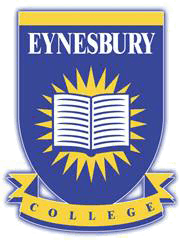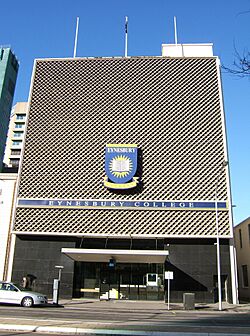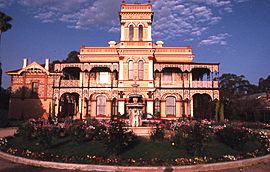Eynesbury Senior College facts for kids
Quick facts for kids Eynesbury Senior College |
|
|---|---|
 |
|

The Franklin Street college campus
|
|
| Address | |
|
5000
Australia
|
|
| Coordinates | 34°55′39″S 138°35′54″E / 34.92750°S 138.59833°E |
| Information | |
| Type | Independent senior high school |
| Motto | Many faces, different pathways – one goal... |
| Established | 1989 |
| Founder | Tony Stimson |
| Closed | December 2021 |
| Principal | Claire Flenley |
| Years offered | 10–12 |
| Newspaper | Eynesbury Times |
Eynesbury Senior College was a special kind of high school in Adelaide, South Australia. It was an independent school, meaning it wasn't run by the government. It was also co-educational, so both boys and girls attended. The college taught students in Years 10, 11, and 12.
The school was known for its unique way of teaching. It focused on helping students get ready for university or other higher studies. Unlike many schools, Eynesbury didn't have lots of sports teams or big festivals. Instead, it offered an "adult learning environment." This meant students were encouraged to be independent. They could even call their teachers by their first names! Teachers were also available for extra help outside of class.
Eynesbury Senior College closed its doors at the end of 2021. This happened because the number of international students, who came from other countries to study there, dropped a lot due to the Coronavirus pandemic.
Contents
History of Eynesbury College
The First Campus: Eynesbury House
| Eynesbury House | |
|---|---|

The Kingswood Campus: Eynesbury House, pictured in 2008
|
|
| Type | Former dwelling; now educational institution |
| Etymology | Eynesbury, Cambridgeshire, England |
| Location | 69 Belair Road, Kingswood, South Australia |
| Area | 5.7 hectares (14 acres) |
| Built | 1880–1881 |
| Built for | William Martin Letchford |
| Architectural style(s) | Italianate, Victorian Filigree |
| Owner | Eynesbury Senior College |
|
South Australian Heritage Register
|
|
| Official name: Eynesbury House (former dwelling) | |
| Designated | 12 January 1984 |
| Reference no. | 11526 |
Eynesbury Senior College first opened in 1989. It was located in a beautiful old mansion called Eynesbury House in the suburb of Kingswood. This house was built a long time ago, between 1880 and 1881. It was named after a place in England called Eynesbury, Cambridgeshire.
Before it became a school, the house was used by a religious group. In 1989, it was changed into a school, with new science labs and a library.
Growing and Moving Campuses
Eynesbury College officially became a registered school on October 1, 1989. The first students, about 140 of them, started in January 1990. At first, it was called Eynesbury House Senior Secondary College, but soon everyone just called it Eynesbury College.
By 1995, the school had grown too big for the Kingswood campus. So, in January 1996, a second, larger campus opened in Franklin Street, right in the middle of Adelaide city. For a few years, Eynesbury had two campuses.
However, by the end of 2001, all teaching moved to the Franklin Street campus. This campus was made bigger and better over time. They added new labs, computer rooms, and even a modern cafe-style area for students to relax. A new Drama centre opened in 2005.
In 2009, Eynesbury celebrated its 20th birthday. Around this time, a new campus opened on Coglin Street in Adelaide. This new campus was mainly for the college's international students.
Why Eynesbury Closed
On June 16, 2021, Eynesbury Senior College announced it would close. The school officially stopped operating at the end of the 2021 school year.
The main reason for the closure was the Covid-19 pandemic. Because of travel restrictions, fewer international students could come to Australia. These international students were a big part of the college's student body and helped support the school financially. Without them, it became very difficult for the college to keep running and offer the high-quality education it was known for. The school looked for other options, like moving or partnering with other schools, but none of them worked out.
What Students Studied
High School Curriculum
Eynesbury Senior College was a specialist school for Years 10, 11, and 12. The main goal was to prepare students for university studies. Classes were longer than in many schools, lasting almost two hours each, with a short break in the middle. Students didn't have to stay on campus if they didn't have a scheduled class.
Students could start in Year 10 or Year 11 at the beginning of either semester. Year 12 students usually started at the beginning of the year. To join, students had an interview to discuss their future plans and how they liked to learn independently. Eynesbury allowed students to take subjects from different year levels if it suited their learning plan.
Year 10 Subjects
In Year 10, all students took core subjects like English (or English as a Second Language), Mathematics, Science, and Studies of Society and Environment. They also had a special class called 'Learning about Thinking'.
Students could choose other subjects, such as:
- Business Studies (learning about money)
- Debating
- Creative Writing
- Drama
- French
- Health and Nutrition
- History Through Film
- Physical Education
- Visual Investigations
All Year 10 students also took part in the Eynesbury Mentor Program, which helped them with their Personal Learning Plan for the SACE (South Australian Certificate of Education).
Year 11 Subjects
In Year 11, students had to study a certain number of subjects. They also started their Research Project, which is a key part of the SACE.
Some of the subjects offered at this level included:
- Accounting
- Biology
- Chemistry
- Drama
- Economics
- English
- French
- Geography
- Information Technology Systems
- Legal Studies
- Mathematics
- Modern History
- Physics
- Psychology
- Visual Arts
Year 12 Subjects
To get into university, Year 12 students needed to complete specific subjects called Tertiary Admissions Subjects (TAS).
Some of the subjects offered in Year 12 were:
- Accounting
- Biology
- Business and Enterprise
- Chemistry
- Classical Studies
- Drama
- Economics
- English Studies
- French
- Geography
- Information Technology Studies
- Legal Studies
- Different levels of Mathematics
- Modern History
- Physics
- Psychology
University Preparation Programs
Eynesbury College also offered special programs called Foundation Studies Programs (FSP). These programs were designed to help students, especially international students, get ready for university. Eynesbury started the first University Foundation Studies Program in South Australia in 1992 for the University of Adelaide. Later, Flinders University and the University of South Australia also joined the program.
Students who completed the FSP successfully could get into their chosen university degree. In 2011, a very high number of students (96%) who finished the FSP went on to university. This program was also recognized by universities in other parts of Australia.
There were different types of FSP programs:
- Standard FSP: This program started in January and finished in December. Students took compulsory courses like Language and Communication, International Studies, and Clear Thinking and Logic. They also chose other subjects.
- Accelerated FSP: This was a faster program that started in April or September and finished in December or July, respectively. It helped students get into university sooner.
- Extended FSP: This program was longer, lasting about 15 months. It was for students who needed extra help with language or key school subjects before starting the main Foundation Studies Program.
Students were assessed throughout the year and with a final exam. Their scores helped them get into university.
See also

